|
|
|
|
|
Oil On
Canvas, Real Flavor of Old Masters
|
|

|
ARTWORKS
INDEX
A B C D E F G H I J K L M N O P Q R S T U V W X Y Z |
ARTISTS
INDEX
A B C D E F G H I J K L M N O P Q R S T U V W X Y Z |
|
|
| | |
|
|
 |
Maclise, Daniel -- Click Here
|
|
Irish Painter, 1806-1870
Irish painter, active in England. He grew up in Cork where his father had set up as a shoemaker after discharge from the British army. In 1822 Maclise went to the Cork Institute where he began to draw from the newly arrived collection of casts made after the antique sculpture in the Vatican, laying the foundation of the strong draughtsmanship that characterizes his mature work. Richard Sainthill, antiquary and connoisseur, encouraged Maclise and introduced him to local literary and artistic circles, which were influenced by the Romantic movement and interested in Irish antiquities and oral traditions. Maclise was a central figure in this early phase of the Irish revival, and maintained an interest in Irish subject-matter throughout his career; in 1833 he painted Snap Apple (Mrs Cantor priv. col.), and in 1841 contributed illustrations to Samuel Carter Hall's Ireland: Its Scenery and Character. When Sir Walter Scott visited Cork in 1825, Maclise made a sketch of him that was lithographed, and that inaugurated his public career. |
|
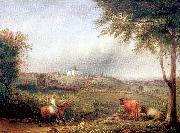 |
MacLeod, William Douglas -- Click Here
|
|
American, 1811-92 |
|
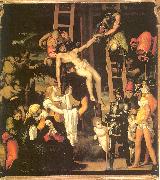 |
Machuca, Pedro -- Click Here
|
|
Spanish, approx. 1490-1550
Spanish painter and architect. The form of his signature (Petrus Machuca, Hispanus. Toletanus ...) on his earliest known work, the Virgin of Succour (1517; Madrid, Prado), suggests he was active at an early age in Italy. On the basis of the style of that work, a number of frescoes in the Vatican have been attributed to him, including Isaiah Blessing Jacob. Other works from the same period that have been attributed to him include a copy (Paris, Louvre) of the destroyed Battle of Anghiari by Leonardo da Vinci and two paintings of the Virgin and Child |
|
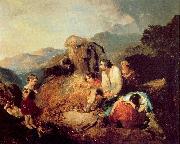 |
MacDonald, Daniel -- Click Here
|
|
Irish Painter, 1821-1853 |
|
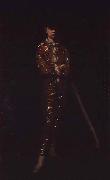 |
Mabel Pryde -- Click Here
|
|
(February 12,1871, Edinburgh - July 1918, England.) was an artist, best known for being the wife of artist William Nicholson and mother of artists Ben Nicholson and Nancy Nicholson and the architect Christopher 'Kit' Nicholson.
Mabel was the daughter of David Pryde, Headmaster of Edinburgh Ladies College 1870-1891, and Barbara Lauder, whose father William was a brother of the famous Scottish artists Robert Scott Lauder and James Eckford Lauder. Mabel had one brother, the artist James Pryde. As children they lived at 10 Fettes Row, a north-facing Edinburgh house.
Pryde trained at the Bushey School of Art under the tutilage of Hubert von Herkomer. Here she met fellow student William Nicholson whom she married in 1893. She introduced Nicholson to her brother James and all three moved to Eight Bells, Denham, Buckinghamshire, where Nicholson and James Pryde would collaborate on the famous series of lithographic posters they disseminated under the pseudonym J. & W. Beggerstaff.
Pryde and Nicholson had four children - Ben (1894-1982); Anthony (1897-1918) who was killed in action during the First World War; Annie Mary "Nancy" (1899-1978), and Christopher "Kit" (1904-1948). In July 1918 Pryde died from influenza in during the 1918 flu pandemic and was survived by her husband.
|
|
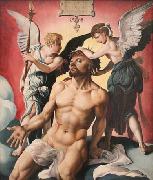 |
Maarten van Heemskerck -- Click Here
|
|
(1498 - 1 October 1574) was a Dutch portrait and religious painter, known for his depictions of the Seven Wonders of the World.
He was born at Heemskerk, North Holland, halfway between Alkmaar and Haarlem.
His father was a small farmer, Jacob Willemsz. van Veen (whose portrait he painted). According to his biography, written by Karel van Mander, he was apprenticed to Cornelis Willemsz in Haarlem. Recalled after a time to the paternal homestead and put to the plough or the milking of cows, young Heemskerk took the first opportunity that offered to run away, and demonstrated his wish to leave home for ever by walking in a single day the 80 km which separate his native hamlet from the town of Delft. There he studied under Jan Lucasz whom he soon deserted for his contemporary Jan van Scorel of Haarlem. Even today, many of Heemskerck's paintings are mistaken for work by van Scorel. He boarded at the home of the wealthy Pieter Jan Foppesz (the van Mander spelling is Pieter Ian Fopsen), curate of the Sint-Bavokerk. He knew him because he owned a lot of land in Heemskerck. This is the same man whom he painted in a now famous family portrait, considered the first of its kind in a long line of Dutch family paintings.
|
|
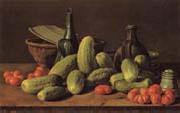 |
Luis Menendez -- Click Here
|
|
1716-1780. a Spanish painter
was a Spanish painter. Although he received little acclaim during his lifetime and died in poverty, Melendez is recognized today as the greatest Spanish still-life painter of the eighteenth century. His mastery of composition and light, and his remarkable ability to convey the volume and texture of individual objects enabled him to transform the most mundane of kitchen fare into powerful images. Luis Egidio Melendez de Rivera Durazo y Santo Padre was born in Naples in 1716. His father, Francisco Melendez de Rivera Diaz (1682- after 1758), was a miniaturist painter from Oviedowho had moved to Madrid with his older brother, the portrait painter Miguel Jacinto Melendez (1679-1734) in pursuit of artistic instruction.Whereas Miguel remained in Madrid to study and became a painter in the court of Philip V, Francisco left for Italy in 1699 to seek greater artistic exposure. Francisco took a special interest in visiting the Italian academies and settled in Naples where he married Maria Josefa Durazo y Santo Padre Barrille.Luis was a year old when his father, who had been a soldier in a Spanish garrison and lived abroad for almost two decades, returned to Madrid with the family. Luis Egidio, his brother Jos' Agusten, and Ana, one of his sisters, began their careers under the tutelage of their father, who was appointed the King's Painter of Miniatures in 1725.After several years, in his words: painting royal portraits in jewels and bracelets to serve as gifts for envoys and ambassadors, he entered the workshop of Louis Michel van Loo (1707-1771), a Frenchman who had been made royal painter of Philip V of Spain. Between 1737 to 1742, Melendez worked as a part of a team of artist dedicated to copying van Loo's prototypes of royal portraits for the domestic and overseas market, but at least he had a foothold in the palace. He had his artistic sights on a distinguished career as a court painter. When the Real Academia de Bellas Artes de San Fernando was provisionally inaugurated in 1744, his father, Francisco, was made an honorary director of painting and Luis was among the first students to be admitted, he achieved outstanding results in drawing. The Academy was progressive in that it not only tolerated but also encouraged the 'lesser' genres, including still life. At this time, he was already an accomplished painter as proved by his superb self-portrait at the Louvre signed in 1747. However, this opportunity was marred by a petty quarrel; Luis' father, Francisco, openly attacked the director of the Academy and claimed for himself the honor of being the founder. He had his son Luis personally delivered the inflammatory material to the Academy. Francisco was relieved of his teaching position and Luis was formally expelled from the Academy on June 15, 1748. Unlike his father, Luis professional status was precarious. |
|
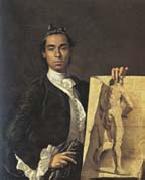 |
Luis Melendez -- Click Here
|
|
1716-80
He assisted his father, artist Francisco Melendez, until 1737, when he began studying with Lewis-Michel Vanloo, the court painter to Philip V of France. Although accepted (1745) into the Spanish Royal Academy of Fine Arts, he was expelled after his father denounced the academy in a dispute over a royal competition. After traveling throughout Italy, he returned to work for his father as an illustrator of choirbooks. |
|
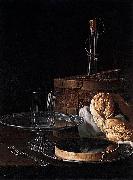 |
Luis Eugenio Melendez -- Click Here
|
|
(Naples, 1716-Madrid, 1780) was a Spanish painter. Although he received little acclaim during his lifetime and died in poverty, Melendez is recognized today as the greatest Spanish still-life painter of the 18th century. His mastery of composition and light, and his remarkable ability to convey the volume and texture of individual objects enabled him to transform the most mundane of kitchen fare into powerful images.
Luis Egidio Melendez de Rivera Durazo y Santo Padre was born in Naples in 1716. His father, Francisco Melendez de Rivera Diaz (1682- after 1758), was a miniaturist painter from Oviedo who had moved to Madrid with his older brother, the portrait painter Miguel Jacinto Melendez (1679-1734) in pursuit of artistic instruction. Whereas Miguel remained in Madrid to study and became a painter in the court of Philip V, Francisco left for Italy in 1699 to seek greater artistic exposure. Francisco took a special interest in visiting the Italian academies and settled in Naples where he married Maria Josefa Durazo y Santo Padre Barrille. Luis was a year old when his father, who had been a soldier in a Spanish garrison and lived abroad for almost two decades, returned to Madrid with the family. Luis Egidio, his brother Jose Agusten, and Ana, one of his sisters, began their careers under the tutelage of their father, who was appointed the King's Painter of Miniatures in 1725. After several years, in his words: painting royal portraits in jewels and bracelets to serve as gifts for envoys and ambassadors, he entered the workshop of Louis Michel van Loo (1707-1771), a Frenchman who had been made royal painter of Philip V of Spain. |
|
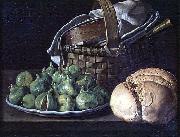 |
Luis Egidio Melendez -- Click Here
|
|
(Naples, 1716-Madrid, 1780) was a Spanish painter. Although he received little acclaim during his lifetime and died in poverty, Melendez is recognized today as the greatest Spanish still-life painter of the 18th century. His mastery of composition and light, and his remarkable ability to convey the volume and texture of individual objects enabled him to transform the most mundane of kitchen fare into powerful images.
Luis Egidio Melendez de Rivera Durazo y Santo Padre was born in Naples in 1716. His father, Francisco Melendez de Rivera Diaz (1682- after 1758), was a miniaturist painter from Oviedo who had moved to Madrid with his older brother, the portrait painter Miguel Jacinto Melendez (1679-1734) in pursuit of artistic instruction. Whereas Miguel remained in Madrid to study and became a painter in the court of Philip V, Francisco left for Italy in 1699 to seek greater artistic exposure. Francisco took a special interest in visiting the Italian academies and settled in Naples where he married Maria Josefa Durazo y Santo Padre Barrille.Luis was a year old when his father, who had been a soldier in a Spanish garrison and lived abroad for almost two decades, returned to Madrid with the family. Luis Egidio, his brother Jose Agusten, and Ana, one of his sisters, began their careers under the tutelage of their father, who was appointed the King's Painter of Miniatures in 1725.After several years, in his words: painting royal portraits in jewels and bracelets to serve as gifts for envoys and ambassadors, he entered the workshop of Louis Michel van Loo (1707-1771), a Frenchman who had been made royal painter of Philip V of Spain. Between 1737 to 1742, Melendez worked as a part of a team of artist dedicated to copying van Loo's prototypes of royal portraits for the domestic and overseas market, but at least he had a foothold in the palace. He had his artistic sights on a distinguished career as a court painter. |
|
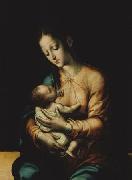 |
Luis de Morales -- Click Here
|
|
(1510 - 9 May 1586) was a Spanish painter born in Badajoz, Extremadura. Known as "El Divino", most of his work was of religious subjects, including many representations of the Madonna and Child and the Passion.
Influenced, especially in his early work, by Raphael Sanzio and the Lombard school of Leonardo, he was called by his contemporaries "The Divine Morales", because of his skill and the shocking realism of his paintings, and because of the spirituality transmitted by all his work.
His work has been divided by critics into two periods, an early stage under the influence of Florentine artists such as Michelangelo and a more intense, more anatomically correct later period similar to German and Flemish renaissance painters
|
|
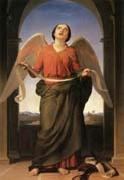 |
Luigi Mussini -- Click Here
|
|
Italian , Berlino, 1813 - Siena, 1888 |
|
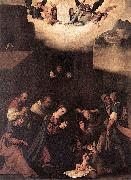 |
Ludovico Mazzolino -- Click Here
|
|
(1480 - c. 1528) - also known as Mazzolini da Ferrara, Lodovico Ferraresa, and Il Ferrarese - was an Italian Renaissance painter active in Ferrara and Bologna.
He was born and died in Ferrara. He appears to have studied under such as Lorenzo Costa, who also trained Dosso Dossi and Cosimo Tura, and came under the influence of Ercole Roberti. In 1521 he married Giovanna, the daughter of Bartolomeo Vacchi, a Venetian painter. Much of his work was commissioned by the duke Ercole I d'Este from Ferrara. Mazzolino was influenced by il Garofalo and Boccaccino. He is known for devotional cabinet pictures, in a style somewhat regressive, or primitive, relative to the modern classicism then emerging. For example, his Massacre canvas has a turbulent and cartoonish crowding.
The exact date, or even year, of his death is not known, but he died during a plague which devastated the area.
|
|
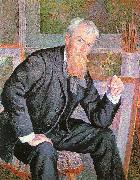 |
Luce, Maximilien -- Click Here
|
|
French Pointillist Painter, 1858-1941
French painter and printmaker. He was born and brought up in the working-class surroundings of Montparnasse, and an interest in the daily routines and labours of the petit peuple of Paris informs much of his art. After an apprenticeship with the wood-engraver Henri Theophile Hildebrand (b 1824), in 1876 he entered the studio of the wood-engraver Eugene Froment where he assisted in the production of engravings for various French and foreign publications such as L'Illustration and The Graphic. He also sporadically attended classes at the Academie Suisse and in the studio of Carolus-Duran. In Froment's studio he came into contact with the artists Leo Gausson and Emile-Gustave Peduzzi |
|
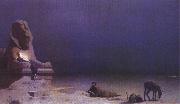 |
Luc - Olivier Merson -- Click Here
|
|
French, 1846 - 1920 |
|
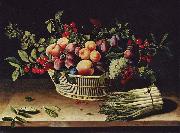 |
Louise Moillon -- Click Here
|
|
(1610-1696) was a French painter in the Baroque era. She became known as one of the best female still life painters during her time, and worked for King Charles I of England, as well as the French nobility.
Moillon came from a strict Calvinist family. Her father, brother Isaac, and stepfather were both paint dealers and artists themselves. According to the RKD, Louise (also known as Louisa) learned to paint from her father Nicolas Moillon and Francois Garnier. She gained her particular style of still life painting from the Academie de Saint-Germain-des-Pres. She usually signed her paintings with Louyse Moillon. Moillon lived and worked in France her whole life. |
|
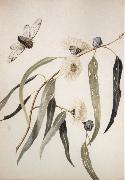 |
Louisa Anne Meredith -- Click Here
|
|
English miniaturist, watercolourist, engraver, poet, writer and botanist .
1812-1895
was an English and Australian writer and illustrator. Louisa Anne Meredith, the daughter of Thomas Twamley and Louisa Ann Meredith, was born near Birmingham, England on 20 July 1812. She was educated chiefly by her mother, and in 1835 published a volume, Poems, which was favourably reviewed. This was followed in 1836 by The Romance of Nature, mostly in verse, of which a third edition was issued in 1839. Another volume was published in the same year, The Annual of British Landscape Scenery, an account of a tour on the River Wye from Chepstow to near its source at Plynlimon. Shortly afterwards Miss Twamley was married to her cousin, Charles Meredith. Charles had emigrated to Van Dieman's Land in 1821 with his father George and family. They had been pioneers of grazing, whaling and other activities around Swansea on Tasmania's East Coast. Charles had become a squatter in the Canberra district of New South Wales They sailed for New South Wales in June 1839, and arrived at Sydney on 27 September 1839. After travelling into the interior as far as Bathurst, Mrs Meredith returned to the coast and lived at Homebush for about a year. By the time of his return to New South Wales, severe economic depression caused by excessive land speculation had destroyed the value of Charles' property, and towards the end of 1840 they relocated to Tasmania. An interesting account of her first 11 years in Australia is given in her two books, Notes and Sketches of New South Wales (1844), reprinted at least twice, and My Home in Tasmania (1852), which was soon republished in the United States of America under the title Nine Years in Australia. For much of her life Mrs Meredith lived on properties around Swansea. In 1860 she published Some of My Bush Friends in Tasmania which contained elaborate full-colour plates printed by the new chromolithography process. The illustrations were drawn by herself, and simple descriptions of characteristic native flowers were given. In the following year an account of a visit to Victoria in 1856, Over the Straits, was published, and in 1880 Tasmanian Friends and Foes, Feathered, Furred and Finned. This went into a second edition in 1881. In 1891, in her eightieth year, Mrs Meredith went to London to supervise the publication of Last Series, Bush Friends in Tasmania. Published at the outset of a severe financial depression in the Australian colonies, this project and the collapse of the bank where most of her savings were held ruined her financially. She died at Melbourne on 21 October 1895 and was survived by sons Owen and George. Mrs Meredith was the author of two novels, Phoebe's Mother (1869), which had appeared in the Melbourne weekly The Australasian in 1866 under the title of Ebba, and Nellie, or Seeking Goodly Pearls (1882). Mrs Meredith took great interest in politics, her husband Charles being a Member of the Tasmanian Legislative Council for several terms between the mid 1850s until just before his death in 1881. |
|
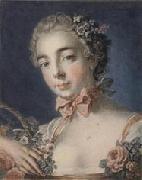 |
Louis-Marin Bonnet -- Click Here
|
|
French, 1736 - 1793
French engraver and publisher. He came from a family of artisans and owed his training in engraving to his brother-in-law, the engraver Louis Legrand (1723-1808). Through Legrand, Bonnet became the pupil of Jean-Charles Francois in 1756, a year before the latter discovered the CRAYON MANNER technique of engraving, designed to reproduce the effect of a coloured-chalk drawing. Around the end of 1757 Bonnet used the new technique to engrave a Cupid after Francois Eisen. Gilles Demarteau, a rival of Jean-Charles Francois |
|
 |
Louis Remy Mignot -- Click Here
|
|
Feb.3.1831-Sep.22.1870
|
|
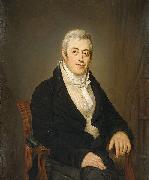 |
Louis Moritz -- Click Here
|
|
painted Portrait of Jonas Daniël Meijer (1780-1834), jurist. in 1800-1834
|
|
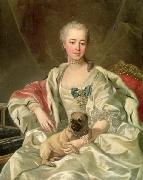 |
Louis Michel van Loo -- Click Here
|
|
Louis-Michel van Loo (2 March 1707-20 March 1771) was a French painter.
He studied under his father, the painter Jean-Baptiste van Loo, at Turin and Rome, and he won a prize at the Academie Royale de Peinture et de Sculpture in Paris in 1725. With his uncle, the painter Charles-Andre van Loo, he went to Rome in 1727 - 1732, and in 1736 he became court painter to Philip V of Spain at Madrid, where he was a founder-member of the Academy in 1752. He returned to Paris in 1753, and painted many portraits of Louis XV of France. In 1765 he succeeded Charles-Andre as director of the special school of the French academy known as the Ecole Royale des Eleves Proteges. In 1766 he made the portrait of the Portuguese statesman Sebastiao de Melo, Marquis of Pombal.
Among his brothers were the painters Francois van Loo (1708 - 1732) and Charles-Amedee-Philippe van Loo (1719 - 1795). |
|
 |
Louis Michel Eilshemius -- Click Here
|
|
(February 4, 1864 - December 29, 1941) was an American painter, primarily of landscapes and nudes. Although he was academically trained, much of his work has the unself-aware character of naive art. Eilshemius was a grandson of Swiss painter Louis-Leopold Robert.
Born near Newark, New Jersey into a wealthy family, his earliest education was in Europe, after which he spent two years at Cornell University before his art studies began at the Art Students League of New York. He subsequently studied under Bouguereau at the Academie Julian in Paris, and traveled widely in Europe, Africa and the South Seas, returning to the family brownstone in New York City where he was to live for the rest of his life. |
|
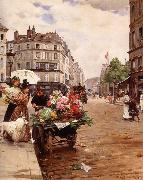 |
Louis Marie de Schryver -- Click Here
|
|
France
1862-1942
|
|
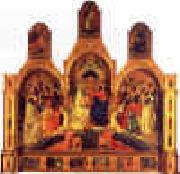 |
Lorenzo Monaco -- Click Here
|
|
Italian
c1370-c1424
Lorenzo Monaco Gallery
was a Florentine painter. He joined the Camaldolese monastery of Santa Maria degli Angeli in Florence in 1391, but he left monastic life before making a lifetime commitment. Despite this fact, he has traditionally been called "Lawrence the Monk." His work shows the influence of the International Gothic style of the late fourteenth century, as well as that of the Sienese school. |
|
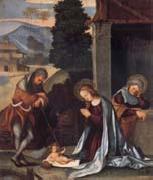 |
Lodovico Mazzolino -- Click Here
|
|
Italian High Renaissance Painter, 1480-1528 |
|
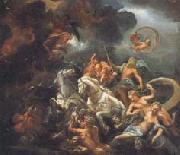 |
Livio Mehus -- Click Here
|
|
The Flemish artist (1627-1691) eclectic painter, author of landscapes, sacred objects, genre paintings and portraits embodies |
|
 |
Lippo Memmi -- Click Here
|
|
active in Tuscany 1317-1347 |
|
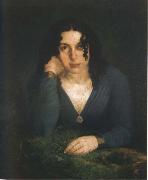 |
Lilly martin spencer -- Click Here
|
|
1822-1902
American painter of English birth. At the age of eight, she and her family emigrated to America, and after three years in New York they moved to Marietta, OH. In 1841 her father took her to Cincinnati, where she exhibited and received help from artists such as the animal painter James Henry Beard (1812-93). However, she refused the offer of the city's most important art patron, Nicholas Longworth, to assist in her art studies in Boston and Europe. Instead she stayed in Cincinnati and married an Englishman, Benjamin Spencer, by whom she had thirteen children, seven living to maturity. |
|
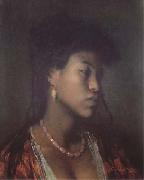 |
Leopold Carl Muller -- Click Here
|
|
Austrian
born 1834 - died 1892 |
|
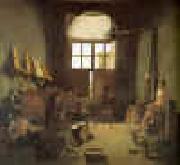 |
Leon-Matthieu Cochereau -- Click Here
|
|
1793-1817
French
Leon-Matthieu Cochereau Location |
|
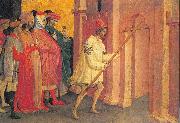 |
Lambertini, Michele di Matteo -- Click Here
|
|
Italian Painter, active 1416-1469 |
|
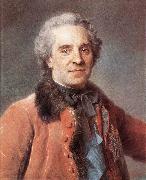 |
LA TOUR, Maurice Quentin de -- Click Here
|
|
French Rococo Era Painter, 1704-1788
French pastellist. He was one of the greatest pastellists of the 18th century, an equal of Jean-Simeon Chardin and Jean-Baptiste Perronneau. Unlike them, however, he painted no works in oils. Reacting against the stately portraits of preceding generations and against the mythological portraits of many of his contemporaries, La Tour returned to a more realistic and sober style of work. The fundamental quality of his art lies in his ability to suggest the temperament and psychology of his subjects by means of their facial expression, and thereby to translate their fugitive emotions on to paper: 'I penetrate into the depths of my subjects without their knowing it, and capture them whole', as he himself put it. His considerable success led to commissions from the royal family, the court, the rich bourgeoisie and from literary, artistic and theatrical circles. |
|
 |
Konstantin Makovsky -- Click Here
|
|
1839 September 17 [O.S. September 30] 1915) was an influential Russian painter, affiliated with the "Peredvizhniki (Wanderers)". Many of his historical paintings, such as The Russian Bride's Attire (1889), showed an idealized view of Russian life of prior centuries. He is often considered a representative of a Salon art.
Konstantin was born in Moscow as the older son of a Russian art figure and amateur painter, Yegor Ivanovich Makovsky. Yegor Makovsky was the founder of Natural class, the art school that later became as the famous Moscow School of Painting, Sculpture and Architecture. Among the friends of the family were Karl Briullov and Vasily Tropinin. All children of Yegor became notable painters (see Makovsky). Later Konstantin wrote For what I became I think I should thank not the Academy or Professors but only my father.
In 1851 Konstantin entered the Moscow School of Painting, Sculpture and Architecture where he became the top student, easily getting all the available awards. |
|
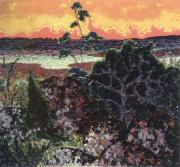 |
konrad magi -- Click Here
|
|
konrad magi(1878 to 1925),was an Estonian landscape painter. He was one of the most colour-sensitive Estonian painters of the first decades of the 20th century, and Magi works on motives of the island of Saaremaa are the first modern Estonian nature paintings.
Magi received his elementary art education from the drawing courses of the German Artisans Society of Tartu (1899?C1902.) At the same time, he was keenly engaged in theater, violin, and various sports.
Magi continued his art education as an unattached student in Saint Petersburg (1903?C1905.) In the autumn of 1907, he went to Paris. There Magi studied at a free academy. From 1908 to 1910, he lived in Norway. In 1912, Magi returned to Tartu, where he worked as an art teacher.
In Åland, he created delicate plant vignettes in the style of Art Nouveau: Kahekesi (Two together; 1908; China ink drawing). In Paris, Magi was influenced by Impressionism and Fauvism, which had a significant impact on his colours: Lilleline vali majakesega (A flower field with a little house; 1908?C1909), Norra maastik manniga (A Norwegian landscape with a pine; 1910).
From 1918, the influence of Expressionism is manifest, fostered by Mägi extreme sensitivity and emotional response to the anxious times: Puhajarv (Lake Puha); 1918?C1920), Otepaa maastik (Landscape of Otepaa; 1918?C1920). Also influenced by Expressionism are his big figure compositions Piet?? (1919), Kolgata (Golgatha; 1921).
Konrad Magi - Rannamaastik (Beach landscape)Magi new artistic period, begun on a trip to Italy, brought calmer tempers: Varemed Capril (Ruins in Capri; 1922?C1923). Along with nature pictures, he painted flowers and portraits. Magi mostly beautiful female models express the Art Nouveau ideal of beauty: Holsti (1916). In his later portraits from the 1920s, a more serious temper is expressed: Madonna (1923?C1924).
|
|
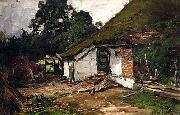 |
Konrad Alexander Muller-Kurzwelly -- Click Here
|
|
painted Gehoft in Mecklenburg in 1885 |
|
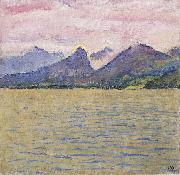 |
Koloman Moser -- Click Here
|
|
Koloman Moser (German pronunciation: [ˈkoːloman ˈmoːzɐ]) (March 30, 1868 - October 18, 1918) was an Austrian artist who exerted considerable influence on twentieth-century graphic art and one of the foremost artists of the Vienna Secession movement and a co-founder of Wiener Werkstätte.
During his life, Moser designed a wide array of art works - books and graphic works from postage stamps to magazine vignettes; fashion; stained glass windows, porcelains and ceramics, blown glass, tableware, silver, jewelry, and furniture - to name a few of his interests.
Born in Vienna, he studied at the Wiener Akademie and the Kunstgewerbeschule, where he also taught from 1899.
His designs in architecture, furniture, jewelry, graphics, and tapestries helped characterize the work of this era. Moser drew upon the clean lines and repetitive motifs of classical Greek and Roman art and architecture in reaction to the Baroque decadence of his turn-of-the-century Viennese surroundings.
In 1901/1902, he published a portfolio titled Die Quelle ("The Source") of elegant graphic designs for such things as tapestries, fabrics, and wallpaper.
In 1903, Moser and his colleague Josef Hoffmann founded Wiener Werkstätte, whose studios and artisans produced a number of aesthetically and functionally designed household goods, including glassware, flatware, silverware, and textiles. In 1904, he created the Apse mosaic and glass windows for the Kirche am Steinhof in Vienna.
Steinhof Church commemorative coin
In 1905, together with the Klimt group, he separated from the Vienna Secession. The same year, he married Editha (Ditha) Mautner von Markhof, the daughter to one of Austria's great industry fortunes.
In 1907 Kolo Moser, due to internal conflicts and as his plans for reorganising the Werkstätte (to cope with financial problems) weren't realised, withdrew from the Wiener Werkstätte.
Koloman was one of the designers for Austria's leading art journal Ver Sacrum. This art journal paid great attention to design and was designed mainly by Moser, Gustav Klimt and Josef Hoffmann.
|
|
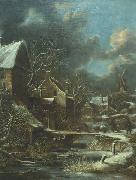 |
Klaes Molenaer -- Click Here
|
|
(1630, Haarlem - 1676, Haarlem), was a Dutch Golden Age painter.
According to the RKD he was the brother of the painters Bartholomeus and Jan Miense Molenaer. He became a member of the Haarlem Guild of St. Luke in 1651 and paid dues yearly until 1676.He was a landscape painter influenced by Jacob van Ruisdael.
|
|
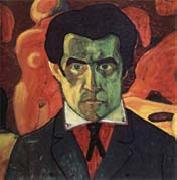 |
Kazimir Malevich -- Click Here
|
|
1878-1935
Russian painter, printmaker, decorative artist and writer of Ukranian birth. One of the pioneers of abstract art, Malevich was a central figure in a succession of avant-garde movements during the period of the Russian revolutions of 1905 and 1917 and immediately after. The style of severe geometric abstraction with which he is most closely associated, SUPREMATISM, was a leading force in the development of CONSTRUCTIVISM, the repercussions of which continued to be felt throughout the 20th century. His work was suppressed in Soviet Russia in the 1930s and remained little known during the following two decades. The reassessment of his reputation in the West from the mid-1950s was matched by the renewed influence of his work on the paintings of Ad Reinhardt and on developments |
|
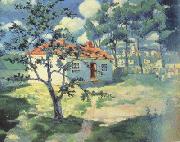 |
Kasimir Sergeevich Malevich -- Click Here
|
|
Ukrainian Cubist Painter, 1878-1935 |
|
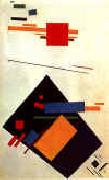 |
Kasimir Malevich -- Click Here
|
|
1878-1935
Kasimir Malevich Gallery
In 1904, after the death of his father, he moved to Moscow. He studied at the Moscow School of Painting, Sculpture and Architecture from 1904 to 1910 and in the studio of Fedor Rerberg in Moscow (1904?C1910). In 1911 he participated in the second exhibition of the group Soyuz Molodyozhi (Union of Youth) in St. Petersburg, together with Vladimir Tatlin and, in 1912, the group held its third exhibition, which included works by Aleksandra Ekster, Tatlin and others. In the same year he participated in an exhibition by the collective Donkey's Tail in Moscow. By that time his works were influenced by Natalia Goncharova and Mikhail Larionov, Russian avant-garde painters who were particularly interested in Russian folk art called lubok. In March 1913 a major exhibition of Aristarkh Lentulov's paintings opened in Moscow. The effect of this exhibition was comparable with that of Paul Cezanne in Paris in 1907, as all the main Russian avant-garde artists of the time (including Malevich) immediately absorbed the cubist principles and began using them in their works. Already in the same year the Cubo-Futurist opera Victory Over the Sun with Malevich's stage-set became a great success. In 1914 Malevich exhibited his works in the Salon des Independants in Paris together with Alexander Archipenko, Sonia Delaunay, Aleksandra Ekster and Vadim Meller, among others.
It remains one of the great mysteries of 20th century art, how, while leading a comfortable career, during which he just followed all the latest trends in art, in 1915 Malevich suddenly came up with the idea of Suprematism. The fact that Malevich throughout all his life was signing and re-signing his works using earlier dates makes this u-turn in his artistic career even more ambiguous. Be that as it may, in 1915 he published his manifesto From Cubism to Suprematism. In 1915-1916 he worked with other Suprematist artists in a peasant/artisan co-operative in Skoptsi and Verbovka village. In 1916-1917 he participated in exhibitions of the Jack of Diamonds group in Moscow together with Nathan Altman, David Burliuk and A. Ekster, among others. Famous examples of his Suprematist works include Black Square (1915) and White on White (1918).
In 1918 Malevich decorated a play Mystery Bouffe by Vladimir Mayakovskiy produced by Vsevolod Meyerhold.
Malevich also acknowledged that his fascination with aerial photography and aviation led him to abstractions inspired by or derived from aerial landscapes. Harvard doctoral candidate Julia Bekman Chadaga writes: ??In his later writings, Malevich defined the 'additional element' as the quality of any new visual environment bringing about a change in perception .... In a series of diagrams illustrating the ??environments' that influence various painterly styles, the Suprematist is associated with a series of aerial views rendering the familiar landscape into an abstraction..." (excerpted from Ms. Bekman Chadaga's paper delivered at Columbia University's 2000 symposium, "Art, Technology, and Modernity in Russia and Eastern Europe"). |
|
|
|
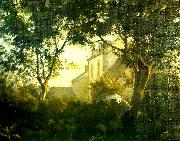 |
karl madsen -- Click Here
|
|
(1855-1938), Danish art historian, director of Statens Museum for Kunst |
|
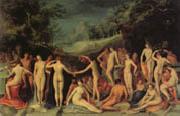 |
Karel van Mander -- Click Here
|
|
Dutch Mannerist Writer and Painter, 1548-1606
was a Flemish-born Dutch painter and poet, who is mainly remembered as a biographer of Netherlandish artists. As an artist he played an important role in Northern Mannerism in the Netherlands. He was born of a noble family at Meulebeke in modern West Flanders. He studied under Lucas de Heere at Ghent, and in 1568-1569 under Pieter Vlerick at Kortrijk. The next five years he devoted to the writing of religious plays for which he also painted the scenery. Then followed three years in Rome (1574-1577), where he is said to have been the first to discover the catacombs. On his return journey he passed through Vienna, where, together with the sculptor Hans Mont, he made the triumphal arch for the royal entry of the emperor Rudolph. In 1583 he settled in Haarlem where he lived and worked for 20 years on a commission by the city fathers to inventory "their" art collection; work that he later published in his "Schilder-boeck" (see below). While in Haarlem he continued to paint, concentrating his energy on his favorite genre: historical allegories. In 1603 he retired to the castle of Sevenbergen in Heemskerk to proofread his book that was published in 1604. |
|
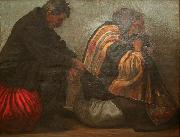 |
Karel Myslbek -- Click Here
|
|
Karel Myslbek (1874-1915)Aliases: Frant. VovesProfessions: Figure painter; Painter. |
|
|
|
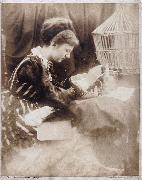 |
Julia Margaret Cameron -- Click Here
|
|
British Photographer, 1815-1879,English pioneer photographer, b. Calcutta (now Kolkata). Born and married into the high ranks of the British civil service, Cameron became an intimate of many of the most famous people of her day. In 1864 she became an ardent amateur photographer, demanding long, arduous sittings from her illustrious friends. She sought to illuminate the inner person of her subject, and her celebrated portraits, including those of Tennyson, Carlyle, Ellen Terry, Browning, Darwin, and Longfellow, are remarkably spontaneous. She also pioneered the use of closeups, |
|
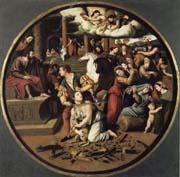 |
Juan Vicente Masip -- Click Here
|
|
Spanish Painter, ca.1475-1545 |
|
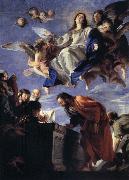 |
Juan Martin Cabezalero -- Click Here
|
|
1633-1673
was a Spanish draftsman and painter. Born in Almaden, he studied under Juan Carreno de Miranda, court painter to Charles II of Spain; Cabezalero lived at Carreno de Miranda's house until 1666. Both he and Carreno were influenced by Van Dyck. Few works by Cabezalero have survived. His surviving works include his St Jerome (1666, Meadows Museum, Southern Methodist University, Dallas) and the Assumption of the Virgin (ca. 1670; Madrid, Prado). The latter had been formerly attributed to Mateo Cerezo, also a pupil of Carreno de Miranda. Antonio Palomino praises Cabezalero's modest, studious nature and laments that he died young. |
|
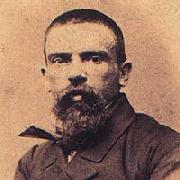 |
Juan Manuel Blanes -- Click Here
|
|
(June 8, 1830 - April 15, 1901) was a noted Uruguayan painter of the Realist school.
Blanes was born in Montevideo, Uruguay, in 1830. He was raised by his mother, with whom he relocated to the countryside in his early teens. Blanes took an interest in drawing at this point, and shortly afterwards, was hired as an illustrator for a Montevideo newsdaily, El Defensor de la Independencia Americana. Earning extra income with watercolors, he returned to his mother and, in 1854, established his first atelier.
He married Marea Linari, and in 1855, the couple settled in Salto, where he worked as a portrait painter. They relocated to Concepcien del Uruguay (across the Uruguay River, in Argentina) in 1857, and Blanes was commissioned by Argentine President Justo Jose de Urquiza to complete a number of portraits, allegories and landscapes to grace his nearby estancia, the Palacio San Jose. Returning to Montevideo in 1861, the talented painter obtained a scholarship from the Uruguayan government, and with it, traveled with his family to Florence, Italy, where he studied under Antonio Ciseri until 1864.
The experience became a valuable calling card for Blanes, who became of Uruguay's most sought-after portraiteurs. The 1871 outbreak of a yellow fever epidemic in Buenos Aires inspired his first renowned work, which he exhibited to acclaim in the recovering city. His 1872 portrait of the Argentine War of Independence hero, General Jose de San Marten (The Review in Rancagua), was also a success in Buenos Aires, and Blanes was invited to Chile to display the historic depiction. |
|
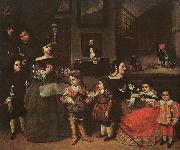 |
Juan Bautista Martinez del Mazo -- Click Here
|
|
1612-1667
Spanish
Juan Bautista Martinez del Mazo Gallery
Mazo??s works owe credit above all to Vel??zquez, whose style he was long compelled to emulate in court portraits. However, Mazo shows in his paintings a personality of his own. His portraits exhibit startling naturalism and marvelously executed. Mazo was specially skillful in painting small figures, a cardinal element in both his hunting scenes and the landscapes he painted as in his most celebrate work View of Saragossa.
Mazo??s palette was rather like that of Vel??zquez, except for a penchant often shown for stressing blue or bluish tints. .The departure from his master style was in his way of shaping people and things by highlights which flash the pictorial image towards the surface of the painting, even from the background.. As a counterbalance, an explicit, even emphatic, perspective design marks out the spatial confines of the composition, making it appear squarish.. A further departure from Velazquez is his luxurious depiction of detail or incident, which he achieved with brilliant, depthless strokes, whether on the figure of a sitter, a curtain on a wall, a floor, the surface of a river, or plain grounds. .These stylistic traits reveal Mazo??s own personality as an artist. .For centuries, Mazo??s paintings were attributed to Vel??zquez, but modern art criticism, techniques and knowledge have been able to separate their works. |
|
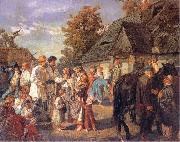 |
jozef marian chelmonski -- Click Here
|
|
Jozef Marian Chełmoski (November 7, 1849 -- April 6, 1914) was a Polish painter.
Chełmoski was born in the village of Boczki near Łowicz in central Congress Poland, Russian Empire. His first drawing teacher was his father (a small leaseholder and administrator of Boczki village). After finishing high school in Warsaw, he studied in Warsaw Drawing Class (1867C1871) and took private lessons from Wojciech Gerson. From 1871 to 1874 Chełmoski lived in Munich. He worked with Polish painters assembled around Jozef Brandt and Maksymilian Gierymski. He also had studied for a few months at the academy of H. Anschutz and A. Strahuber. In 1872 and 1874 Chełmoski visited the Polish territories (Poland as a country did not exist then), Tatra Mountains and Ukraine.
His first paintings were done under the influence of Gerson. The works that followed were landscapes and villages. In 1875 Chełmoski went to Paris, where he had many important exhibitions and became known to the art scene. With many orders, the artistic level of his paintings decreased.
From 1878 to 1887 Chełmoski visited Poland, Vienna and Venice. In 1887 he returned to Poland and in 1889 settled in Kuklewka Zarzeczna village. Contact with his homeland and nature revealed quality in his artworks. From that time are the best liked Chełmoski's paintings such as Partridge on the Snow, The Storks or Before Thunderstorm.
Chełmoski represented the trend in art called "Polish Patriotic Painting".
He died in Kuklewka near Grodzisk Mazowiecki in 1914.
|
|
 |
Jozef Marian Chelmonski -- Click Here
|
|
(November 7, 1849 - April 6, 1914) was a Polish painter.
Chełmoeski was born in the village of Boczki near Łowicz in central Congress Poland, Russian Empire. His first drawing teacher was his father (a small leaseholder and administrator of Boczki village). After finishing high school in Warsaw, Jozef studied in Warsaw Drawing Class (1867-1871) and took private lessons from Wojciech Gerson. From 1871 to 1874 Chełmoeski lived in Munich. He worked with Polish painters assembled around Jozef Brandt and Maksymilian Gierymski. There, he also studied for a few months at the academy of H. Anschutz and A. Strahuber. In 1872 and 1874 Chełmoeski visited the Polish Territories (Poland, as an independent country, did not exist during this time), Tatra Mountains and Ukraine.
His first paintings were done under the influence of Gerson. The works that followed were landscapes and villages. In 1875 Chełmoeski went to Paris, where he had many important exhibitions and became known to the art scene. With many orders, the artistic level of his paintings decreased.
From 1878 to 1887 Chełmoeski visited Poland, Vienna and Venice. In 1887 he returned to Poland and in 1889 settled in the village of Kuklewka Zarzeczna. Contact with his homeland and nature are qualities revealed in his artworks. From that time are the best liked, or the most beloved of Chełmoeski's paintings are paintings such as Partridge on the Snow, The Storks or Before Thunderstorm.
|
|
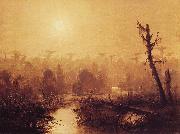 |
Joseph Rusling Meeker -- Click Here
|
|
(1827 -1887 ) - Painter
|
|
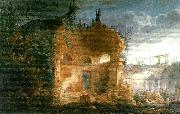 |
joseph michael gandy -- Click Here
|
|
Joseph Michael Gandy (1771 - 1843) was an English artist, visionary architect and architectural theorist, most noted for his imaginative paintings depicting Sir John Soane's architectural designs. He worked extensively with Soane both as draughtsman and creative partner from 1798 until 1809 when he (ultimately unsuccessfully) set up his own practice.
Gandy built little in his career, having a reputation as a difficult individual to deal with. However his work included the Phoenix Fire and Pelican Life Insurance Offices (1804?C1805, destroyed ca. 1920) in London, Doric House at Sion Hill in Bath (1818), and the remodelling of Swerford Park house in Oxfordshire (1824?C1829). Commercially he was a failure and served two terms in a debtors' prison, but his published and exhibited work was largely a critical and popular success. In 1821 he published two articles in the Magazine of Fine Arts on The Philosophy of Architecture. He intended to expand upon this subject in an eight-volume work entitled Art, Philosophy and Science of Architecture, of which his unpublished manuscript survives.
His paintings show a dramatic use of two-point perspective and architectural precision, and also reflect his (and Soane's) fascination with Roman ruins. His architectural fantasies owe a clear debt to Piranesi and play upon historical, literary and mythological themes with a feeling for the sublime that is the equal of his contemporaries J. M. W. Turner and John Martin.
He died in a private asylum in Devon where he had been placed by his family in 1839. Many of his paintings can be seen in the Pictures Room of Sir John Soane's Museum in London. |
|
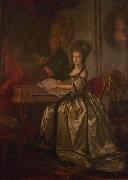 |
Joseph Melling -- Click Here
|
|
Joseph Melling (1724-1796)
|
|
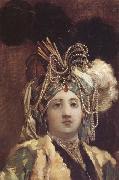 |
Joseph Marie Vien -- Click Here
|
|
French Neoclassical Painter, 1716-1809
French painter, draughtsman and engraver. He was one of the earliest French painters to work in the Neo-classical style, and although his own work veered uncertainly between that style and the Baroque, Vien was a decisive influence on some of the foremost artists of the heroic phase of Neo-classicism, notably Jacques-Louis David, Jean-Fran?ois-Pierre Peyron, Joseph-Benost Suve and Jean-Baptiste Regnault, all of whom he taught. Both his wife, Marie-Therese Reboul (1738-1805), and Joseph-Marie Vien fils (1762-1848) were artists: Marie-Therese exhibited at the Salon in 1757-67 |
|
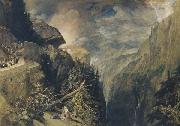 |
Joseph Mallord William Truner -- Click Here
|
|
born: London, England; 23 April 1775 died: London, England; 19 December
1851. |
|
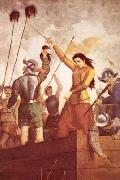 |
Jose Mercedes Ortega -- Click Here
|
|
painted Dona Ines de Suarez in defending the city of Santiago in 1897 |
|
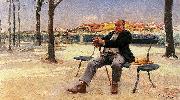 |
Jose Malhoa -- Click Here
|
|
(Caldas da Rainha, 28 April 1855 ; Figueire dos Vinhos, 26 October 1933) was a Portuguese painter.
Malhoa was, with Columbano Bordalo Pinheiro, the leading name in Portuguese naturalist painting, in the second half of the 19th century. He painted often popular scenes and subjects, like his two most famous paintings, "The Drunks" (1907) and "Fado" (1910). He always remained faithful to the naturalist style, but in some of is works, there are impressionist influences, like in his "Autumn" (1918), that can be considered as an "impressionist exercise".
He saw at the end of his life, the inauguration of the Jose Malhoa Museum, in Caldas da Rainha.
|
|
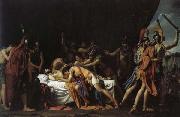 |
jose Madrazo Y Agudo -- Click Here
|
|
Spanish Neoclassical Painter, 1781-1859
was a Spanish painter of the Neoclassic period. Born in Santander. Studied in Madrid with Cosme de Acuna and Gregorio Ferro, both rectors of the Academia de San Fernando at the beginning of the 19th century. Don Fernando La Serna, who was named ambassador to France at the time, brought Madrazo to Paris, where he entered the studio of Jacques-Louis David. There, under royal patronage from King Carlos IV, he executed a painting of the Death of Lucretia and other canvases on events from classic Greco-Roman history. He moved to Rome during Napoleonic times, where he was briefly jailed for failing to complete oaths of loyalty to the newly installed Napoleon II of France as King of Rome. In Rome, he was admitted to the Accademia di San Luca. King Carlos IV named him pintor de camara (painter of the chamber), a position confirmed by King Ferdinand VII. |
|
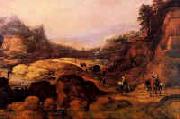 |
Joos de Momper -- Click Here
|
|
Flemish Baroque Era Painter, 1564-1635
known as Josse de Momper, is one of the most important Flemish landscape painters between Pieter Brueghel the Elder and Peter Paul Rubens. Brueghel's influence is clearly evident in this many of de Momper's paintings.
Born in 1564 in Antwerp, Joos de Momper was first apprenticed to his father. In the 1580s, he travelled to Italy to study art. De Momper primarily painted landscapes, the genre for which he was well-regarded during his lifetime. He painted both fantasy landscapes, viewed from a high vantage point and employing a conventional Mannerist color transition of brown in the foreground to blue and finally green in the background, and more realistic landscapes with a lower viewpoint and more natural colors. His wide panoramas also feature groups of figures. Only a small number of the 500 paintings attributed to De Momper are signed, and just one is dated. |
|
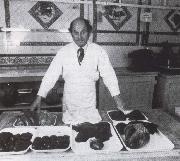 |
jonathan miller -- Click Here
|
|
(born July 21, 1934, London, Eng.) British director, writer, and actor. After earning a medical degree at Cambridge University, he made his professional stage debut at the Edinburgh Festival in the hit satirical revue Beyond the Fringe (1960). |
|
 |
John Mundell -- Click Here
|
|
painted Punting Down the River in 19th Century
|
|
|
|
|
|
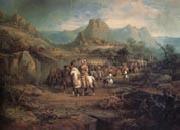 |
John Mix Stanley -- Click Here
|
|
A famous painter of Indians and Indian scen .
American , 1814-1872
American , 1814-1872,was an American painter of landscapes, portraits and Native American life. He was born in Canandaigua, New York and orphaned at the age of 12. At age 14, Stanley became an apprentice to a coach maker. Looking for better work, he moved to west in 1832 and became a painter of signs and portraits. In spring 1843 Stanley accompanied the party of Indian agent Pierce M. Butler to the Tehuacana Creek Council. At the outbreak of the Mexican War in 1845, John Mix Stanley joined Colonel Stephen Watts Kearney's expedition to California and produced many sketches and paintings of the campaign. He traveled to Hawaii in 1848 and spent a year painting portraits of members of the royal family. He traveled across the Isthmus of Panama in 1853. He also painted Comanche warriors in their natural environment. He moved to Detroit in 1864 and remained there for the rest of his life. Stanley helped to found a forerunner of the Detroit Institute of Arts and to incorporate the National Gallery and School of Arts. Stanley's primary interests and sympathies were with the Indians. The Smithsonian exhibited his pictures, but Congress never appropriated monies for them. More than 200 of his works were destroyed in the Smithsonian fire of 1865. |
|
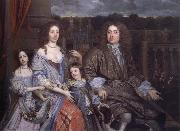 |
John Michael Wright -- Click Here
|
|
English Baroque Era Painter, ca.1617-1694,was a British baroque portrait painter. Wright trained in Edinburgh under the Scots painter George Jamesone, and acquired a considerable reputation as an artist and scholar during a long sojourn in Rome. There he was admitted to the Accademia di San Luca, and was associated with some of the leading artists of his generation. He was engaged by Archduke Leopold Wilhelm of Austria, the governor of the Spanish Netherlands, to acquire artworks in Oliver Cromwell's England in 1655. He took up permanent residence in England from 1656, and served as court painter before and after the English Restoration. A convert to Roman Catholicism, he was a favourite of the restored Stuart court, a client of both Charles II and James II, and was a witness to many of the political manoeuvrings of the era. In the final years of the Stuart monarchy he returned to Rome as part of an embassy to Pope Innocent XI. Wright is currently rated as one of the leading indigenous British painters of his generation and largely for the distinctive realism in his portraiture. Perhaps due to the unusually cosmopolitan nature of his experience, he was favoured by patrons at the highest level of society in an age in which foreign artists were usually preferred. Wright's paintings of royalty and aristocracy are included amongst the collections of many leading galleries today. |
|
 |
John Melhuish Strudwick -- Click Here
|
|
1849-1937
British
John Melhuish Strudwick Gallery |
|
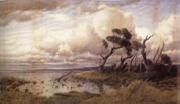 |
John Mather -- Click Here
|
|
Australian painter, etcher and teacher.
1848-1916
|
|
|
|
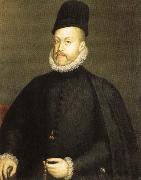 |
john masefield -- Click Here
|
|
(born June 1, 1878, Ledbury, Herefordshire, Eng. ?? died May 12, 1967, near Abingdon, Berkshire) English poet. He went to sea in his youth, then lived precariously for several years in the U.S. before settling in London. He is best known for his poems of the sea, Salt-Water Ballads (1902, including "Sea Fever" and "Cargoes"), and for his long narrative poems, such as The Everlasting Mercy (1911), containing phrases of colloquial coarseness that were unknown in earlier 20th-century English verse. After he became poet laureate in 1930, his poetry became more austere. He also wrote adventure novels, sketches, and works for children.
|
|
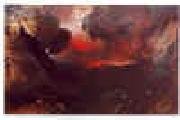 |
John Martin -- Click Here
|
|
British
1789-1854
John Martin Gallery
His first exhibited subject picture, Sadak in Search of the Waters of Oblivion (now in the St. Louis Art Museum), was hung in the Ante-room of the Royal Academy in 1812, and sold for fifty guineas. It was followed by the Expulsion (1813), Paradise (1813), Clytie (1814), and Joshua Commanding the Sun to Stand Still upon Gibeon (1816). In 1821 appeared his Belshazzar's Feast, which excited much favorable and hostile comment, and was awarded a prize of £200 at the British Institution, where the Joshua had previously carried off a premium of £100. Then came the Destruction of Herculaneum (1822), the Creation (1824), the Eve of the Deluge (1841), and a series of other Biblical and imaginative subjects. The Plains of Heaven is thought to reflect his memories of the Allendale of his youth.
Martin's large paintings were inspired by "contemporary dioramas or panoramas, popular entertainments in which large painted cloths were displayed, and animated by the skilful use of artificial light. Martin has often been claimed as a forerunner of the epic cinema, and there is no doubt that the pioneer director D. W. Griffith was aware of his work." In turn, the diorama makers borrowed Martin's work, to the point of plagiarism. A 2000-square-foot version of Belshazzar's Feast was mounted at a facility called the British Diorama in 1833; Martin tried, but failed, to shut down the display with a court order. Another diorama of the same picture was staged in New York City in 1835. These dioramas were tremendous successes with their audiences, but wounded Martin's reputation in the serious art world. |
|
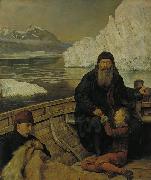 |
John Maler Collier -- Click Here
|
|
(27 January 1850 - 11 April 1934), called 'Jack' by his family and friends, was a leading English artist, and an author. He painted in the Pre-Raphaelite style, and was one of the most prominent portrait painters of his generation. Both his marriages were to daughters of Thomas Henry Huxley. He studied painting at the Munich Academy where he enrolled on 14 April 1875 (Register: 3145) at the age of 25.
Collier was from a talented and successful family. His grandfather, John Collier, was a Quaker merchant who became a Member of Parliament. His father (who was a Member of Parliament, Attorney General and, for many years, a full-time judge of the Privy Council) was created the first Lord Monkswell. He was also a member of the Royal Society of British Artists. John Collier's elder brother, the second Lord Monkswell, was Under-Secretary of State for War and Chairman of the London County Council.
Collier's first wife, Marian Huxley, 1883In due course, Collier became an integral part of the family of Thomas Henry Huxley PC, sometime President of the Royal Society. Collier married two of Huxley's daughters and was "on terms of intimate friendship" with his son, the writer Leonard Huxley. Collier's first wife, in 1879, was Marian (Mady) Huxley. She was a painter who studied, like her husband, at the Slade and exhibited at the Royal Academy and elsewhere. After the birth of their only child, a daughter, she suffered severe post-natal depression and was taken to Paris for treatment where, however, she contracted pneumonia and died in 1887.
In 1889 Collier married Mady's younger sister Ethel Huxley. Until the Deceased Wife's Sister's Marriage Act 1907 such a marriage was not possible in England, so the ceremony took place in Norway. Collier's daughter by his first marriage, Joyce, was a portrait miniaturist, and a member of the Royal Society of Miniature Painters. By his second wife he had a daughter and a son, Sir Laurence Collier KCMG, who was the British Ambassador to Norway 1941-51.
|
|
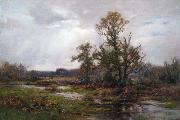 |
John MacWhirter -- Click Here
|
|
(27 March 1839 Slateford, Water of Leith - 28 January 1911 London) was a Scottish landscape painter.
John was the third of four children. He attended a school in Colinton, and after his father's death was apprenticed to Oliver & Boyd, booksellers in Edinburgh. He stayed there for only a few months and then in 1851 enrolled at the Trustees Academy under Robert Scott Lauder and John Ballantyne (1815-97). He spent long periods sketching and studying nature outdoors. His first painting to be exhibited at the Royal Scottish Academy at age 14, was 'Old Cottage at Braid'. In 1880, he was made an Honorary Member of the Royal Scottish Academy. Exploring and painting abroad he visited Italy, Sicily, Switzerland, Austria, Turkey, Norway and the U.S.A. - the Alps being a great inspiration. He moved to London in 1867 and on 4 May 1893 was elected a Royal Academician.
MacWhirter specialised in romantic landscapes with a great fondness for trees, spending much time in the hilly countryside of Perthshire. Initially, under the influence of John Everett Millais, he experimented with the detailed images of the Pre-Raphaelites, but later adopted a more sweeping style. With John Pettie he illustrated The Postman's Bag (Strahan, 1862), and Wordsworth's Poetry for the Young (Strahan, 1863). |
|
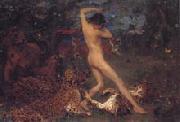 |
John Macallan Swan -- Click Here
|
|
British Academic Painter, 1847-1910
was an English painter and sculptor. John Macallan Swan was born in Brentford, Middlesex in 1847. He received his art training first in England at the Worcester and Lambeth schools of art and the Royal Academy schools, and subsequently in Paris, in the studios of Jean-L??on G??rôme and Emmanuel Fr??miet. He began to exhibit at the Academy in 1878, and was elected associate in 1894 and academician in 1905. He was appointed a member of the Dutch Water-Colour Society in 1885; and associate of the Royal Society of Painters in Water Colours in 1896 and full member in 1899. A master of the oil, water-colour and pastel mediums, an accomplished painter and a skilful draughtsman, he ranks also as a sculptor of distinguished ability. He has treated the human figure with notable power, but it is by his representations of the larger wild animals, mainly the felidae, that he chiefly established his reputation; in this branch of practice he has scarcely a rival. His picture "The Prodigal Son," bought for the Chantrey collection in 1889, is in the National Gallery of British Art. |
|
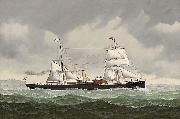 |
John Henry Mohrmann -- Click Here
|
|
painted The Belgian steamer Amelie bound for Spain in |
|
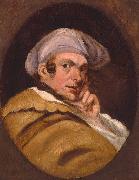 |
John Hamilton Mortimer -- Click Here
|
|
ARA (1740-1779) was a British Neoclassical figure and landscape painter and printmaker, known for romantic paintings set in Italy, works depicting conversations, and works drawn in the 1770s portraying war scenes, similar to those of Salvator Rosa.
Mortimer became President of the Society of Artists in 1774, five years before his death, at age 39.
John Hamilton Mortimer was born on 17 September 1740 at Eastbourne. Not much is known about his family, other than that his father was a customs officer, a dealer in flour and owner of several mills. By 1757, while he was still young, he was studying in London at the Duke of Richmond's Academy. During this time he became a friend of Joseph Wright, a fellow student at the Academy - a friendship which would endure throughout Mortimer's life. Mortimer is also known to have had some professional relationship with the artist Samuel Ireland, who was involved with etching Mortimer's work. At the St Martin's Lane Academy his fellow students included Thomas Jones and William Pars. In 1759 Mortimer won a first prize for a study after Michelangelo's Bacchus and a second prize for a life drawing.
He began to display his works on a regular basis from the early 1760s onwards. He became an active member of the Society of Artists and President of the Society in 1774. |
|
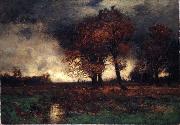 |
John Francis Murphy -- Click Here
|
|
(December 11, 1853 - January 30, 1921), American landscape painter.
He was born at Oswego, New York and first exhibited at the National Academy of Design in 1876, and was made an associate in 1885 and a full academician two years later. He became a member of the Society of American Artists (1901) and of the American Watercolor Society. At first influenced by Wyant and Inness, after 1900 he attacked the modern problems of light and air, thus combining the old and new theories of landscape painting. His chief characteristics are extreme refinement and charm, poetic sentiment, and beauty of surface. His composition is simple and his rendering of soil unique. A past master of values, he preferred the quiet and subdued aspects of nature. He received numerous awards, including a gold medal at Charleston (1902) and the Inness medal in 1910. |
|
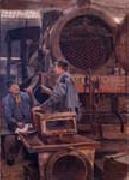 |
Johannes Martini -- Click Here
|
|
(9 June 1866 C 7 February 1935) was a German oil painter and graphic artist.
Martini was born in Chemnitz, Saxony. He was a student of Franz Skarbina at the Akademie der Kenste of Berlin, and he spent two years at the Acad??mie Julian in Paris. Martini exhibited his work at the Great Art Exhibition in Berlin and the Paris Salon. He participated in the jubilee exhibit for the 90th birthday of Luitpold of Bavaria, as well as the Annual Exhibition in Berlin's Glass Palace. |
|
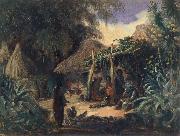 |
Johann Moritz Rugendas -- Click Here
|
|
Augsburg 1802-1858 Weilheim an der Teck,was a German painter, famous for his works depicting landscapes and ethnographic subjects in several countries in the Americas, in the first half of the 19th century. Rugendas was born to the seventh generation of a family of noted painters and engravers of Augsburg (he was a grandson of Georg Philipp Rugendas, 1666-1742, a celebrated painter of battles), and studied drawing and engraving with his father, Johann Lorenz Rugendas II (1775-1826). From 1815 to 1817 he studied with Albrecht Adam (1786-1862), and later in the Academy de Arts of Munich, with Lorenzo Quaglio II (1793-1869). Inspired by the artistic work of Thomas Ender (1793-1875) and the travel accounts in the tropics by Austrian naturalists Johann Baptist von Spix (1781-1826) and Carl von Martius (1794-1868), Rugendas arrived in Brazil in 1821, where he was soon hired as an illustrator for Baron von Langsdorff's scientific expedition to Minas Gerais and Sao Paulo. Langsdorff was the consul-general of the Russian Empire in Brazil and had a farm in the northern region of Rio de Janeiro, where Rugendas went to live with other members of the expedition. In this capacity, Rugendas visited the Serra da Mantiqueira and the historical towns of Barbacena, Sao Joao del Rei, Mariana, Ouro Preto, Caete, Sabara and Santa Luzia. |
|
|
|
|
| | |
|
|
|
|